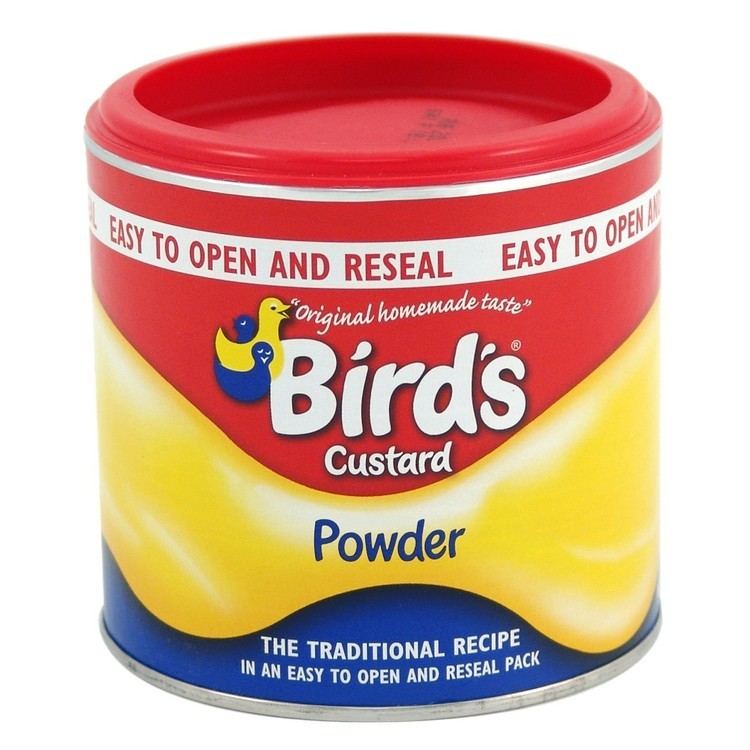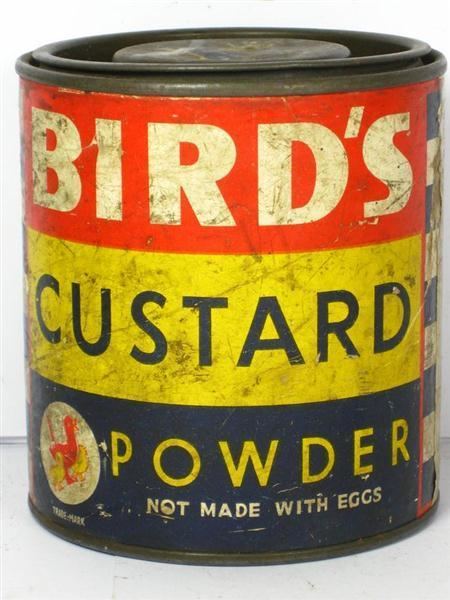Main ingredients cornflour, milk | ||
 | ||
Similar Custard, Snow skin mooncake, Custard cream, Egg tart, Baking powder | ||
Bird's Custard is the brand name for the original powdered, egg-free imitation custard powder, now owned by Premier Foods. Custard powder or instant custard powder are the generic product names for similar and competing products. The product is a cornflour-based powder which thickens to form a custard-like sauce when mixed with milk and heated.
Contents
- Twisted adverts bird s custard
- History
- Usage
- Brand recognition
- Controversy
- Alfred Bird and Sons Ltd
- Physical properties
- References

Twisted adverts bird s custard
History

Bird's Custard was first formulated and first cooked by Alfred Bird in 1837 at his Chemist Shop, in Birmingham because his wife was allergic to eggs, the key ingredient used to thicken traditional custard.
Usage

In some regions, such as Australia and the United Kingdom, the popularity of this type of dessert is such that it is simply known as "custard". In such cases, general usage of the word may be more likely to refer to the "Bird's" custard rather than to the traditional egg-based variety.

Bird's Custard and other brands mimicking its composition are also popular in India, where a large portion of the populace follows a vegetarian diet, although ovo-lacto variants are also available.

In recent years, "instant" versions (containing powdered milk and sugar and requiring only hot water) and ready-made custard in tins, plastic pots and cartons have also become popular.
Brand recognition

A food and drink survey carried out in 2000 found 99% of customers recognised the brand, which accounts for 45% of the custard consumed in the UK. Bird's Custard is also exported to several countries. Bird's Custard can often be found in many popular grocery supermarkets.
In addition to the Bird's brand, generic cornflour-based custards are widely available.
Controversy
Until 2009 many Bird's products, such as its instant custard powder, contained hydrogenated vegetable oil, a product now banned in some countries due to health concerns relating to heart disease. Since then all Bird's custards have moved to non-hydrogenated vegetable oil.
Alfred Bird and Sons Ltd.
After he discovered his custard was popular, Bird formed Alfred Bird and Sons Ltd. in Birmingham. By 1843, the company was also making the newly invented baking powder and, by 1844, was promoting custard powder nationally. By 1895, the company was producing blancmange powder, jelly powder, and egg substitute. In World War I, Bird's Custard was supplied to the British armed forces.
The company was one of the early users of promotional items and colourful advertising campaigns. The famous 'three bird' logo, however, was relatively late in arriving, only introduced in 1929.
World War II saw rationing and serious production limits. Shortly after the war, Bird's was purchased by the General Foods Corporation, which was itself taken over by Philip Morris in the 1980s and merged into Kraft Foods. Although the Bird's Custard product remains, the company itself is now just a brand. In late 2004, Kraft sold Bird's Custard and some other Kraft brands to Premier Foods, who are the current owners.
In 1958, the company acquired Monk and Glass, a rival custard powder manufacturer based in London.
The original custard factory has long ceased to exist, but the larger factory Bird's opened in Gibb Street remains (production was relocated to Banbury in 1964, along with the factory gates, featuring the company logo), and has been adapted as the Custard Factory arts centre.
In 1981, a dust explosion occurred at the Banbury factory when corn starch powder mixed with air, forming an explosive mixture.
Physical properties
Though cooked custard is a weak gel, viscous and thixotropic, a suspension of uncooked custard powder (starch) in water, with the proper proportions, has the opposite rheological property: it is negative thixotropic, or dilatant, which is to say that it becomes more viscous when under pressure. This suspension is termed oobleck and often used in science demonstrations of non-Newtonian fluids. The popular-science programme Brainiac: Science Abuse demonstrated dilatancy dramatically by filling a swimming pool with this mixture and having presenter Jon Tickle walk across it.
